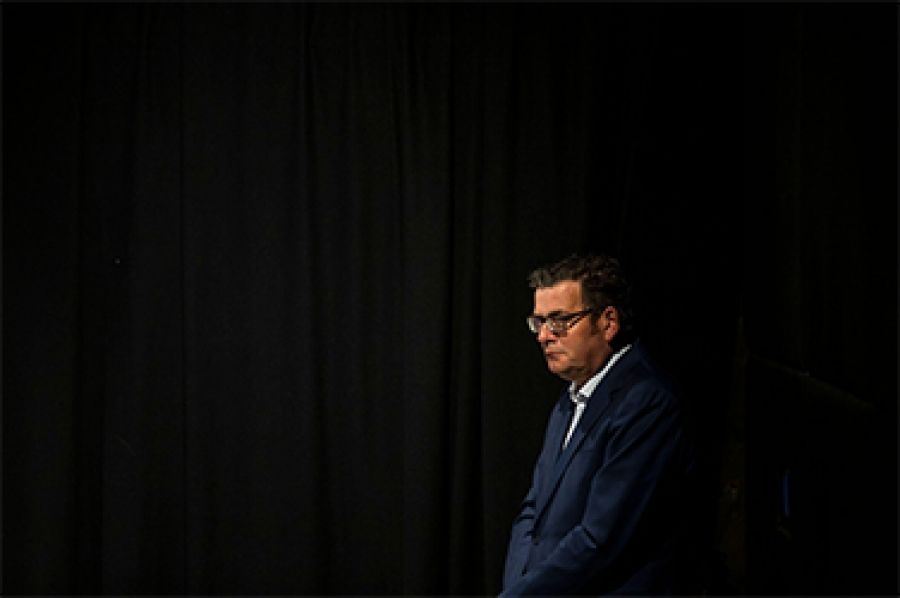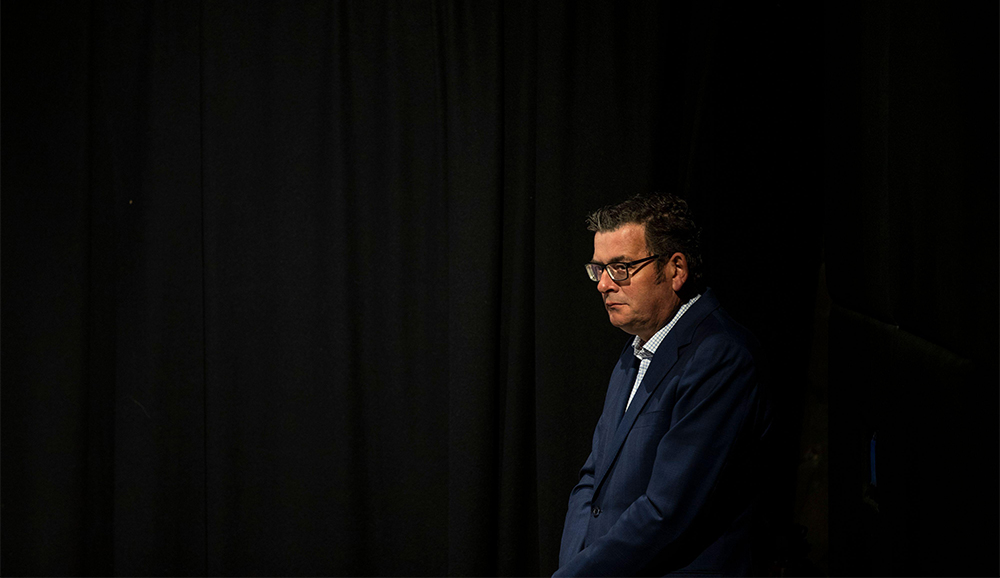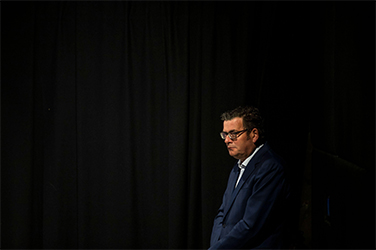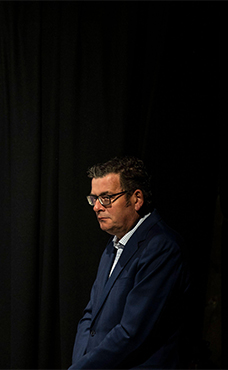
- Free Article: No
- Contents Category: Commentary
- Custom Article Title: A tale of two Melbournes: Election time for the poster boy of progressive politics
- Review Article: Yes
- Article Title: A tale of two Melbournes
- Article Subtitle: Election time for the poster boy of progressive politics
- Online Only: No
- Custom Highlight Text:
It was in the wake of the landslide re-election of Daniel Andrews’s Labor government in November 2018 that the former Coalition prime minister, John Howard, christened Victoria ‘the Massachusetts of Australia’. Coming from Howard, this characterisation of Victoria was not meant as a compliment. Rather, it seemed designed as a consolation message for the local Liberal Party. He was providing them with an alibi for their lengthening record of under-performance in the state. Victoria, Howard seemed to be saying, was simply impervious to the party’s conservative values.
- Article Hero Image (920px wide):

- Article Hero Image Caption: Victorian Premier Daniel Andrews (photograph by Diego Fedele/ZUMA Press Inc/Alamy)
- Alt Tag (Article Hero Image): Victorian Premier Daniel Andrews (photograph by Diego Fedele/ZUMA Press Inc/Alamy)
- Featured Image (400px * 250px):

- Alt Tag (Featured Image): 'A tale of two Melbournes: Election time for the poster boy of progressive politics' by Paul Strangio
Whatever Howard’s intention, it is true enough that Victoria, like Massachusetts historically, can claim to be the nation’s heartland of progressive politics. To some extent, this is merely a continuation of an older tradition that stretches back to the colonial era when Victorian politics was defined by a creative liberal reformism – an impulse carried onto the national political stage in the early Commonwealth by Alfred Deakin. In more recent times, Rupert Hamer, Liberal premier of the state during the 1970s, epitomised liberal reformism. Dubbed the ‘liberal Liberal’ by his biographer, Hamer, who was a three-time election winner, pursued a ‘quality of life’ agenda characterised by care for the environment, nurturing of the arts, equal opportunity, heritage preservation, and education. The 1970s was, however, a decade of transition in Victorian politics. Hamer’s tenure ended unhappily in 1981. He was white-anted by party insurgents who, in temperament and ideology, anticipated the neo-conservative activists who colonised the Victorian Liberal Party in the 1980s and set out to remake it in their own image.
Meanwhile, Victorian Labor was undergoing its own transformation. After the devastating split of the mid-1950s over the issue of Catholic-led anti-communism, the party had become a byword for failure. It was on its way to losing nine consecutive elections. Federal intervention in the branch at the beginning of the 1970s, however, broke the stranglehold of the militant industrial unions that had exercised iron control over the party in the post-split era and which had been inhospitable to new ideas and were stubbornly uninterested in electoral success. Following this intervention, there was an influx of middle-class professionals and an accompanying outburst of policy generation: a blooming of a hundred flowers. It was Labor that now became the closest thing there is to a custodian of the liberal reformist tradition in Victorian politics. Though other factors such as electoral reform and demographic change have played their part, this transformation in the ideological positioning of the major parties is critical to understanding the dramatic shift in the pattern of electoral politics in Victoria since the beginning of the 1980s.
Left-of-centre dominance in Victorian politics over the past four decades is reflected in both federal and state election results. In the sixteen national elections since 1980, Labor has won the two-party preferred vote in Victoria on no fewer than fourteen occasions (the exceptions being 1990 and 2004). Indeed, not only would there not have been a Howard era if Victoria had had its way, but Tony Abbott, Malcolm Turnbull, and Scott Morrison would also never have been prime minister. Similarly, at a state level, Labor has won nine of the past eleven elections dating back to 1982. This has translated into the ALP ruling over Spring Street for three-quarters of the past four decades.
Raw numbers alone, however, are insufficient to convey the progressive bent of Victorian politics. It is the way the state has been governed. The record of the Andrews administration has exemplified this. Andrews, Australia’s longest-serving head of government, is himself a fascinating political case study. Two things stand out about his political background. First, it exhibits the hallmarks of a quintessential Labor apparatchik; the second is its rapidity. Following graduation from Monash University, where he majored in politics, Andrews became an electorate officer and factional enforcer for the federal Labor MP, Alan Griffin, before stints as an organiser and then assistant state secretary for the Victorian ALP. In November 2002, aged thirty, he won a seat in the Legislative Assembly and was immediately appointed as a parliamentary secretary in the second Steve Bracks government. Elevated to the ministry by 2006, when the ALP lost office he was elected opposition leader in November 2010. Four years later, at age forty-two, he was premier of Victoria.
One of the perversities of the modern party apparatchik is that having schemed their way into parliamentary office from a tender age, once there they commonly lack the wherewithal to meaningfully exercise power. They resemble the dog that catches the truck. It is as if they have spent too much time obsessing about the object of their ambition at the expense of grasping its purpose. Andrews has proved different. From the moment he obtained the premiership in November 2014, he has been determined to put his stamp on the state. He not only understands power but relishes its exercise, a combination that is surprisingly rare among politicians. What is more, Andrews has recognised that in Victoria there is licence to push the boundaries of reform. In fact, we might say that under his leadership the state has become a kind of laboratory for progressive experimentation in Australia.
Evidence abounds of the quiet revolution unleashed by the Andrews government. It has embarked upon a gargantuan public works program. Given the public relations appellation of ‘Victoria’s big build’, the program encompasses a dizzying suite of projects. They include the removal of scores of railway level crossings, the Melbourne metro rail project, an airport rail link, a suburban rail loop, and an array of road extensions and upgrades headed by the Westgate tunnel and North East Link projects. It is not only the scale of the infrastructure investment that is striking but the way in which the government is financing it. The Andrews administration is interring the nostrums of neoliberalism under a mountain of public debt. It is unashamedly a big-government regime.
Perhaps more interesting still is Labor’s adventurous social reform program. The Andrews government has burnished its progressive credentials through a raft of measures: for example, establishing the state’s first drug injecting room, strongly supporting the Safe Schools program, appointing a Royal Commission into Family Violence, legislating protection zones around abortion clinics, decriminalising sex work, and banning LGBTIQ+ conversion practices. In addition, following an attempt by the Northern Territory to legalise euthanasia in the 1990s – a move thwarted by the Howard government – under the Andrews government Victoria became the first Australian jurisdiction to successfully introduce voluntary assisted dying in 2017.
Probably the most fascinating of all the initiatives being currently pursued by the Andrews government is its pioneering of a process for concluding a treaty with the state’s Indigenous communities: a process launched against the background of the federal Coalition government’s spurning of proposals contained in the 2017 Uluru Statement from the Heart by Indigenous Australians for a treaty and truth-telling commission. Since 2019, an elected First Peoples’ Assembly has been in place in Victoria, invested with the responsibility for creating the framework for treaty negotiations. A ‘truth telling’ commission has been created as part of the treaty process. This body is to inquire into injustices committed against First Peoples dating back to the earliest days of colonisation and may investigate the potential for reparations to be paid to Indigenous Victorians for historical wrongs. Most recently, legislation has been passed for the establishment of an authority composed entirely of First Nations people to oversee the treaty process. The body is autonomous from government – it is not required to report to a minister, and its funding is insulated from the usual political cycles.
All of this activity has made Andrews something of a poster boy of progressive politics, not just in Victoria but across the nation. On the other hand, the combination of ideological boldness and the premier’s forceful leadership style has made Andrews a large target. It is not an exaggeration to say that he incites loathing in conservative circles. The antagonism is mutual. When faced with criticism, Andrews plays the political hard man. He barely disguises his contempt for his accusers. One of his tactics is to freeze out critics: for example, boycotting Melbourne’s top-rating morning talkback radio program and thumbing his nose at the state’s News Corp tabloid, The Herald Sun. This is part of a larger innovative communications strategy centred on direct engagement with the public through social media. Andrews is a prolific user of Twitter, more active in that space than any other Australian head of government. Bypassed by the premier, The Herald Sun’s commentators produce a blizzard of newsprint campaigning against Andrews, to little apparent effect. Some of the criticisms are legitimate; after eight years in office, his government has racked up more than its share of scandals and mistakes. According to opinion polls, none, however, has lethally dented the premier’s standing. Members of the parliamentary press gallery ruefully call him ‘Teflon Dan’.
The divided views about Andrews were sharpened by his management of the Covid-19 pandemic. The Labor government’s botched hotel quarantine program unleashed a second wave of the virus in Victoria in mid-2020 and led to the imposition of tight lockdown restrictions on citizens: stricter than those experienced in any of the other states. The failures here were real, not least defective coordination and lack of accountability. For Andrews, who has prided himself on his control of his government and mastery of detail, it must have been a humbling experience. He responded with perhaps the only way he knew how: by asserting greater control over his government and upping an already onerous workload. So were born his daily media briefings on the Covid outbreak that continued unabated for four months. He became at this time a figure of national curiosity, second only to Prime Minister Scott Morrison in the media attention he garnered. To his critics in this period, he was ‘Dictator Dan’, trampling on civil liberties, while supporters rallied behind him with an online ‘Stand with Dan’ campaign. It was a striking polarisation of opinion about Andrews that has persisted.
In November 2022, Victorians will go back to the polls to decide if the Andrews government is to be renewed for a third term. Victory would extend Labor’s tenure to a dozen years and provide Andrews with the opportunity to become the second-longest-serving premier in the state’s history, behind the postwar Liberal behemoth, Henry Bolte (1955–72). What makes the contest especially intriguing is that it will be the first election since the 2022 federal poll, which was a watershed in the movement of support away from the major parties. There is likely to be a similar trend in November, injecting volatility into the result. Not least because of the size of its majority (nearly twenty seats), Labor is favoured to retain office. At the same time, it is inevitable that the Andrews government will be unable to match the primary vote of forty-three per cent it achieved in 2018. How much of the vote Labor loses will go to the Coalition is another matter.
Both Labor and the Coalition will be harried by minor parties and independents at November’s poll. Inspired by the success of the Teal candidates federally, the organisation Climate 200 has already flagged that it is likely to sponsor similar campaigns in the Victorian election in affluent inner-city electorates. This prospect has left a wounded Liberal Party internally debating how much it should stake on those electorates. In the opinion of one of its outspoken conservative MPs, the party ought to ‘stop obsessing with the Woke concerns’ of ‘inner urban élites’. Meanwhile, Labor too will be challenged in the inner city. Emboldened by its strong performance in the national poll, the Greens are confident of snatching at least a couple of inner-city seats from Labor.
Yet it will not only be in the inner city where the major parties will be under pressure. At the federal election, there were large swings against Labor in some of its safest outer suburban and fringe metropolitan seats. The peak was in the Melbourne northern suburbs electorate of Scullin, where Labor lost fourteen per cent of its primary vote. What distinguishes these seats is that they are not only working class but also highly ethnically diverse.
To some extent, the swings in the outer suburban seats can be explained by a general disenchantment with the major parties, with Labor losing votes not to the Liberal Party but rather to a melange of minor parties (including One Nation and United Australia). On the other hand, critics of the Andrews government have suggested that there was a local factor behind the swings: a residual anger about the harsh lockdowns in areas that had less social capital to weather months of restrictions. The argument goes that while voters in the affluent inner city were attending Zoom work meetings during the day and promenading around parks in the evenings, in working-class outer suburbs voters were struggling with a different and harsher reality of life during the pandemic. The fierce anti-lockdown rallies in Melbourne during the latter months of 2021, the intensity of which surprised many Victorians, were an expression of the resentments built up in that period.
In other words, did the federal election result hint at two Melbournes, one affluent and confidently progressive, the other struggling and aggrieved? If so, the coming state poll will be more than a referendum on the Andrews government: it will be a barometer of the social cohesion of Australia’s progressive state.
This is one of a series of politics columns generously supported by the Judith Neilson Institute for Journalism and Ideas.



Comments powered by CComment